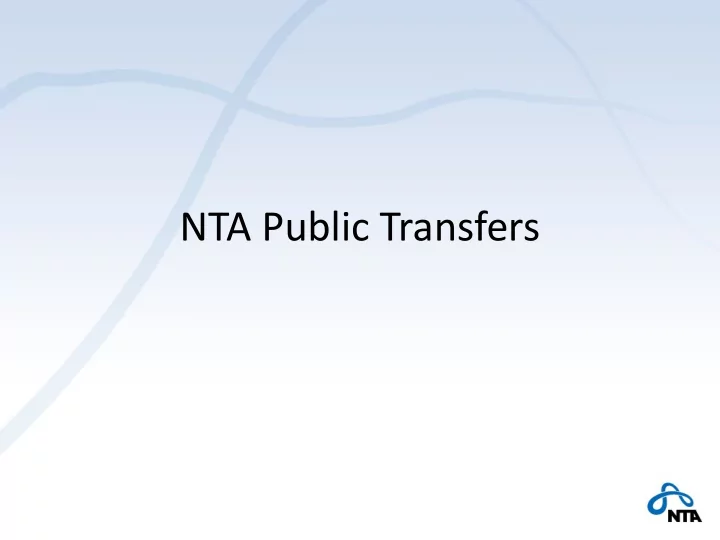

NTA Public Transfers
NTA Flow Identity Inflow = Outflow 𝑍 𝑀 𝑏 + 𝑍 𝐵 𝑏 + 𝜐 + 𝑏 = 𝐷 𝑏 + 𝑇 𝑏 + 𝜐 − 𝑏 Lifecycle Deficit = Age Reallocations 𝐷 𝑏 − 𝑍 𝑀 𝑏 = 𝑍 𝐵 𝑏 − 𝑇 𝑏 + 𝜐 net 𝑏 𝑜𝑓𝑢 𝑏 + 𝜐 𝐺 𝜐 net 𝑏 = 𝜐 𝐻 𝑜𝑓𝑢 𝑏
Public Sector SNA 2008, 4.127: The general government consists of the following groups of residential institutional units • All units of central, state or local government • All non-market non-profit institutions that are controlled by government units • Also includes social security funds, either as separate institutional units or as part of any central, state or local government Public enterprises or profit-making activities, i.e. public corporations, are excluded
Function of Public Sector in NTA 1. Transfer resources across age groups • Cash transfers (vouchers, taxes, ...) • In- kind transfers (education, defense, …) 2. Manage public assets • Borrows and lends thereby create public wealth/debt • Pay/receive income on public financial assets/debt
Transfers Transfers are flows that involve no explicit quid pro quo obligations. – Many transfers may involve implicit obligations, e.g. transfers between children and parents – Retirement benefits paid to public workers as part of their employment contracts are not transfers, i.e. they are deferred payments for labor
Public Transfers • Public transfer systems consists of a set of mutually exclusive and exhaustive programs • Programs vary widely across countries: – Broad sectors, e.g. health, education – Specific program, e.g. Conditional Cash Transfer • Source of funding: General or Specific • NTA emphasis on age dimension of programs and of funding sources
Public Transfers, Inflows • In-Kind Transfers (Public Consumption) – Education, Health, Others – Reimbursement for health care included as in-kind • Cash transfers – Social security benefits – Social assistance benefits in cash – Pension programs – Grants, …
Public Transfers, Outflows • Taxes – Direct taxes – Indirect taxes (net of subsidies) – Other revenues, e.g. fees, fines, etc. • Social security contributions • Transfer surplus/deficit – Derived in NTA, no SNA/GFS counterpart • Grants
Public Transfers Schematic By Purpose Total Total By Source By Purpose In-kind Taxes and other revenues Outflow Cash In-Kind = Inflow Transfer In-kind deficit Cash Net Public Net Public In-kind Transfers Transfers Cash from ROW from ROW Cash
Three Important Questions (TIQ) 1. How large is each program? • Expenditure and source of funding 2. Which age groups benefit? • Transfer inflows assigned to age group of intended/actual beneficiaries of the program 3. Which age groups bear the cost? • Transfer outflows are assigned to tax payers based on tax incidence rule
How large is each program? • Public Sector Inventory: Identify purpose and source of funding of government programs – Administrative documents – IMF Government Financial Statistics (GFS) – System of National Accounts • Specific programs with clear age-based component, e.g. cash transfer programs, tobacco/liquor taxation
Which age groups benefit? • Inflows In-Kind same as Public Consumption • Cash Transfers, Inflows – Targeted programs: assign to age group of beneficiaries using survey or other sources – Untargeted programs: use headship
Which age groups bear the cost? • By source, i.e. type of outflow, including taxes (net of subsidies), social contributions, grants, other revenues • By purpose, i.e. function of government • Assigned based on tax incidence rule • Transfer deficit: Use unobligated taxes
NTA: Public Transfers
NTA: Taxes
Tax and age profile indicators NTA Profile and Macro-control Age-profile indicator Private Consumption Various Labor Income Wages, Self-employment Private Asset Income - Capital Income Corporations and NPISH Dividends, interest and rent income Owner-occupied Housing Household imputed rent assigned to head Share of mixed income Share assigned to head - Property Income Inflows Dividends, interest and rent income Outflows Consumer credit Household interest expense Other property income outflows Dividends, interest and rent income
Reference United Nations (2013). National Transfer Accounts Manual: Measuring and Analysing the Generational Economy . New York: United Nations. [Chapters 6 and 7]
Recommend
More recommend